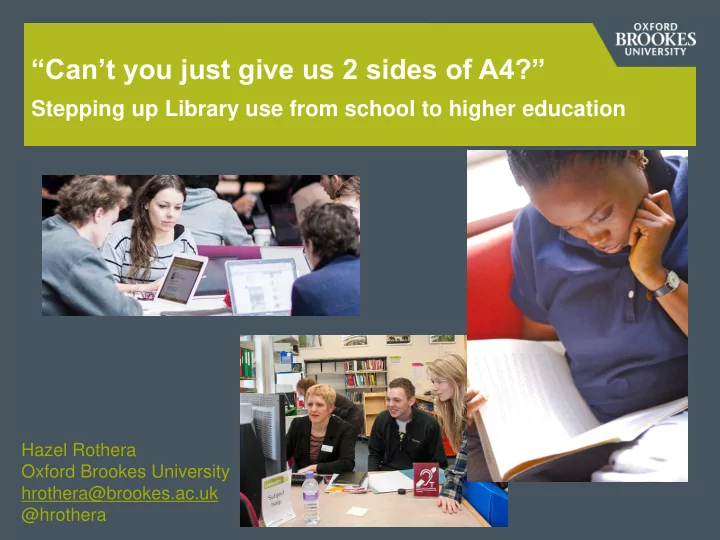

“Can’t you just give us 2 sides of A4?” . Stepping up Library use from school to higher education Hazel Rothera Oxford Brookes University hrothera@brookes.ac.uk @hrothera
Perspectives on the issue Evidence What? My from experience students Evidence Evidence So what? Now what? from from the colleagues literature (Brookfield’s four lenses ) (Rolfe et al’s reflective model )
What are we seeing?... In the last ten years search tools have gone from this…
… to this
Shift in support: from finding to understanding and using Was I supposed to That student read the stuff on the didn’t know what reading list? the key terms meant Time, comprehension, They can find journal strategic/surface articles now but still don’t approach, use them because they say metacognitive they don’t understand them issues…
So what… (does that mean?) • Students find the idea of long-form reading very offputting • They find it difficult to engage with lengthy, dense texts, especially online • Tension between wanting convenience of e-texts and finding paper easier to read and comprehend • Need support with the idea that it is possible to learn to be an academic reader (and then thinker and writer) • … but they need to put the work in to achieve that
Now what… do we do? (Croft, 2018)
The information ladder… …until you can understand the in -depth Research is mostly reported research findings. in journal articles … read article abstracts Abstracts are summaries of the key points of a journal article …get the background from a textbook… Textbooks from the Library … use a dictionary to learn any words you’re not familiar with… Look in our Quick Ref section or online Read a basic but reliable introduction to the topic… (good quality Wikipedia article, encyclopedia entry, reliable Web site) Y ou’ll need to work your way up the information ladder!
… and the reading iceberg Kils & Bodo, commons.wikimedia.org
Elsewhere in the sector… • Workshops aimed at supporting students to become ambassadors for more effective information literacy practices (eg SADL project, LSE 2013-2016) • Academics rethinking what , how and why they expect students to read and how they communicate this – building reading resilience (eg Australian Learning & Teaching Council 2010-2012) • Explicitly teaching pre-reading strategies – course structure, key points of readings, connections between readings, teach the structure of a journal article • Communities of practice where academic staff and librarians work together on issues of critical information literacy (eg York St John)
And what do you do?... Do you recognise the situation I’ve described? What’s causing it? Does it matter? If so, what does that mean for school librarians, teachers and school leaders?
References Brookfield, S (1995) Becoming a critically reflective teacher. San Francisco: Jossey-Bass. (Brief open- access explanation of Brookfield’s four lenses here.) Croft, D (2018. What is a reading list for? Oxford: Oxford Brookes University. (Available open access here.) Croft, D (2018) Embedding constructive alignment of reading lists in course design. Journal of Librarianship and Information Science. (Open-access preprint available here.) Duncan, L (2016). Adolescent reading skill and engagement with digital and traditional literacies as predictors of reading comprehension. British Journal of Psychology 107(2), 209- 238, (Open-access preprint available here.) Information Learning & Estates, York St John University (n.d.) Information in the curriculum . (Available here.) Jenks, A (2016). Why don’t students read? Teaching Tools, Cultural Anthropology website. (Available here.) Kennedy et al (2014). The reading resilience toolkit . Canberra: Australian National University. (Available here.)
References (continued) Mizrachi et al (2018). Academic reading format preferences and behaviors among university students worldwide: A comparative survey analysis. PLoS One . (Available open access here.) Rolfe, G et al (2001) Critical reflection for nursing and the helping professions: a user’s guide . Basingstoke: Palgrave. (Brief open- access explanation of Rolfe’s reflective model here.) Rothera, H (2015) Picking up the cool tools: working with strategic students to get bite-sized information literacy tutorials created, promoted, embedded, remembered and used. Journal of Information Literacy 9(2), 37-61. (Available open access here.) Secker, J (2017) ‘Students in the SADL: lessons from LSE’s digital literacy programme’. In: Reedy & Parker (eds), Digital Literacy Unpacked . London: Facet, pp 83-96. (Chapter available open access here.) Singer, L, and Alexander, P (2017). Reading across mediums: effects of reading digital and print texts on comprehension and calibration. Journal of Experimental Education 85(1), 155- 172. (Available open access here.) Weimer, M (2010). 11 strategies for getting students to read what’s assigned (Faculty Focus Special Report). Madison, Wis.: Magna. Available open access here.
“Can’t you just give us 2 sides of A4?” . Stepping up Library use from school to higher education … questions? Hazel Rothera Oxford Brookes University hrothera@brookes.ac.uk @hrothera
Recommend
More recommend